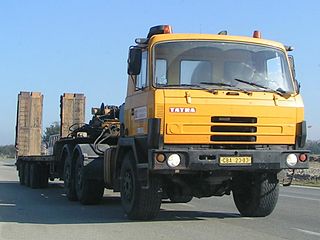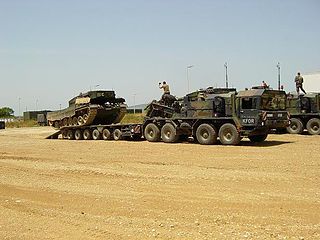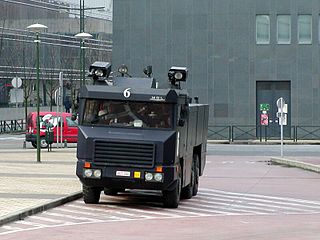
Heavy equipment, heavy machinery, earthmovers, construction vehicles, or construction equipment, refers to heavy-duty vehicles specially designed to execute construction tasks, most frequently involving earthwork operations or other large construction tasks. Heavy equipment usually comprises five equipment systems: the implement, traction, structure, power train, and control/information.

The Tatra 815 is a truck family, produced by Czech company Tatra. It uses the traditional Tatra concept of rigid backbone tube and swinging half-axles giving independent suspension. The vehicles are available in 4x4, 6x6, 8x8, 10x8, 10x10, 12x8 and 12x12 variants. There are both air-cooled and liquid-cooled engines available with power ranging from 230–440 kilowatts (310–590 hp). As a successor to Tatra 813 it was originally designed for extreme off-road conditions, while nowadays there are also variants designated for mixed use. The gross weight is up to 35,500 kg (78,264 lb).

Nicolas Industrie S.A.S. is a French manufacturer of heavy trucks, trailers, HMT and SPMTs, mostly intended for oversize loads. Nicolas has been located in Champs-sur-Yonne since 1969, which is also when they started to develop vehicles meant particularly for very heavy loads. Their trucks, sold under the Tractomas brand, are built to single order. They most often incorporate Renault cabs and other parts, as well as a number of proprietary parts from manufacturers around the world. The Nicolas Tractomas TR1010 D100 currently holds the record as the world's largest road going truck, weighing in at 71 tonnes.

The Autocar Company is an American specialist manufacturer of severe-duty, Class 7 and Class 8 vocational trucks, with its headquarters in Birmingham, Alabama. Started in Pittsburgh, Pennsylvania, in October 1897 as a manufacturer of early Brass Era automobiles, and trucks from 1899, Autocar is the oldest surviving motor vehicle brand in the Western Hemisphere.
Scammell Lorries Limited was a British manufacturer of trucks, particularly specialist and military off-road vehicles, between 1921 and 1988. From 1955 Scammell was part of Leyland Motors.

The M19 tank transporter was a heavy tank transporter system used in World War II and into the 1950s. It consisted of a 12-ton 6×4 M20 Diamond T model 980 truck and companion 12-wheel M9 trailer.

A tractor unit, also known as a truck unit, lorry unit, power unit, prime mover, ten-wheeler, semi-tractor, semi-truck, semi-lorry, tractor cab, truck cab, lorry cab, big rig tractor, big rig truck or big rig lorry or simply a tractor, truck, lorry, semi, big rig or rig, is a characteristically heavy-duty towing engine that provides motive power for hauling a towed or trailered load. These fall into two categories: heavy- and medium-duty military and commercial rear-wheel-drive semi-tractors used for hauling semi-trailers, and very heavy-duty typically off-road-capable, often 6×6, military and commercial tractor units, including ballast tractors.

Demag was a German heavy equipment industrial group whose individual companies are now scattered. The Demag name can be today found for example as the Demag Cranes and Components and Sumitomo (SHI) Demag.

Cab-over, also known as cab over engine (COE), cab forward or flat face (U.S.), flat nose (Canada), or forward control (UK), is a body style of truck, bus, or van that has a vertical front, "flat face" or a semi-hood, with the cab of the truck sitting above the front axle. This contrasts with a conventional truck where the engine is mounted in front of the driver.

The Volvo FM is a heavy truck range produced by the Swedish company Volvo Trucks. It was originally introduced as FM7, FM10 and FM12 in 1998. FM stands for Forward control Medium height cab, where the numbers denominate an engine capacity in litres. As of 2005 the engine size is no longer added to the model denomination. The FM range is a multipurpose truck range for distribution, construction and on highway/off highway transport duties. In 2013, Volvo Trucks announced an updated, Euro VI version of the Volvo FM.

A ballast tractor is a specially weighted tractor unit of a heavy hauler combination. It is designed to utilize a drawbar to pull or push heavy or exceptionally large trailer loads which are loaded in a hydraulic modular trailer. When feasible, lowboy-style semi-trailers are used to minimize the height of a load's center of mass. Typical drivetrains are 6×4 and 6×6, but 8×6 and 8×8 are also available. Typical ballast tractor loads include oil rig modules, bridge sections, buildings, ship sections, and industrial machinery such as generators and turbines.

A tank transporter is a combination of a heavy tractor unit or a ballast tractor and a mating full trailer, hydraulic modular trailer or semi-trailer, used for transporting tanks and other armoured fighting vehicles. Some also function as tank recovery vehicles, the tractors of which may be armoured for protection in combat conditions.

The SLT 50 is a heavy-duty tractor unit and tank transporter used by the German Army and Polish Army.
Tadano Ltd. is the main and largest Japan-based manufacturer of cranes and aerial work platforms, considered one of largest crane manufacturers in the world.

The MAN Category 1 is a family of high-mobility off-road trucks developed by MAN SE for the German army. Production continued through an evolution of the design with the final iteration (SX) in production until early 2019.

Willème was a French truck manufacturer, specializing in heavy- and special-duty trucks.

MOL is a manufacturer of specialist trucks and trailers, based in Hooglede, Belgium. Specializes in manufacturing of trailers, waste vehicles, port equipement, trucks and rail equipments.

Nicolas Industrie S.A.S. is a French manufacturer of heavy trucks, trailers, HMT and SPMTs, mostly intended for oversize loads. Nicolas has been located in Champs-sur-Yonne since 1969, which is also when they started to develop vehicles meant particularly for very heavy loads. Their trucks, sold under the Tractomas brand, are built to single order. They most often incorporate Renault cabs and other parts, as well as a number of proprietary parts from manufacturers around the world. The Nicolas Tractomas TR1010 D100 currently holds the record as the world's largest road going truck, weighing in at 71 tonnes.

The Leyland Hippo was a 6x4 heavy general service cargo truck manufactured by Leyland Motors. Introduced in 1929, it remained in production for 40 years.

A hydraulic modular trailer (HMT) is a special platform trailer unit which feature swing axles, hydraulic suspension, independently steerable axles, two or more axle rows, compatible to join two or more units longitudinally and laterally and uses power pack unit (PPU) to steer and adjust height. These trailer units are used to transport oversized load, which are difficult to disassemble and are overweight. These trailers are manufactured using high tensile steel, which makes it possible to bear the weight of the load with the help of one or more ballast tractors which push and pull these units via drawbar or gooseneck this combination of tractor and trailer is also termed as heavy hauler.























